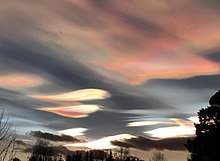| Polar stratospheric cloud | |
|---|---|
 Antarctic stratospheric cloud (nacreous clouds) Antarctic stratospheric cloud (nacreous clouds) | |
| Abbreviation | PSC |
| Altitude | 15,000–25,000 m (49,000–82,000 ft) |
| Classification | Other |
| Appearance | Glowing brightly with vivid iridescent colors |
| Precipitation | No |

Polar stratospheric clouds (PSCs) are clouds in the winter polar stratosphere at altitudes of 15,000–25,000 m (49,000–82,000 ft). They are best observed during civil twilight, when the Sun is between 1 and 6 degrees below the horizon, as well as in winter and in more northerly latitudes. One main type of PSC is made up mostly of supercooled droplets of water and nitric acid and is implicated in the formation of ozone holes. The other main type consists only of ice crystals which are not harmful. This type of PSC is also referred to as nacreous (/ˈneɪkriəs/, from nacre, or mother of pearl, due to its iridescence).
Formation

The stratosphere is very dry; unlike the troposphere, it rarely allows clouds to form. In the extreme cold of the polar winter, however, stratospheric clouds of different types may form, which are classified according to their physical state (super-cooled liquid or ice) and chemical composition.
Due to their high altitude and the curvature of the surface of the Earth, these clouds will receive sunlight from below the horizon and reflect it to the ground, shining brightly well before dawn or after dusk.
PSCs form at very low temperatures, below −78 °C (−108 °F). These temperatures can occur in the lower stratosphere in polar winter. In the Antarctic, temperatures below −88 °C (−126 °F) frequently cause type II PSCs. Such low temperatures are rarer in the Arctic. In the Northern hemisphere, the generation of lee waves by mountains may locally cool the lower stratosphere and lead to the formation of lenticular (lens-shaped) PSCs.

Forward scattering of sunlight within the clouds produces a pearly-white appearance. Particles within the optically thin clouds cause colored interference fringes by diffraction. The visibility of the colors may be enhanced with a polarising filter.
Types

PSCs are classified into two main types each of which consists of several sub-types
- Type I clouds have a generally stratiform appearance resembling cirrostratus or haze. They are sometimes sub-classified according to their chemical composition which can be measured using LIDAR. The technique also determines the height and ambient temperature of the cloud. They contain water, nitric acid and/or sulfuric acid and are a source of polar ozone depletion. The effects on ozone depletion arise because they support chemical reactions that produce active chlorine which catalyzes ozone destruction, and also because they remove gaseous nitric acid, perturbing nitrogen and chlorine cycles in a way which increases ozone depletion.
- Type Ia clouds consist of large, aspherical particles, consisting of nitric acid trihydrate (NAT).
- Type Ib clouds contain small, spherical particles (non-depolarising), of a liquid supercooled ternary solution (STS) of sulfuric acid, nitric acid, and water.
- Type Ic clouds consist of metastable water-rich nitric acid in a solid phase.
- Type II clouds, which are very rarely observed in the Arctic, have cirriform and lenticular sub-types and consist of water ice only.

Only Type II clouds are necessarily nacreous whereas Type I clouds can be iridescent under certain conditions, just as any other cloud. The World Meteorological Organization no longer uses the alpha-numeric nomenclature seen in this article, and distinguishes only between super-cooled stratiform acid-water PSCs and cirriform-lenticular water ice nacreous PSCs.
See also
References
- ^ "Polar stratospheric clouds / Observations". Australian Antarctic Division. Archived from the original on June 2, 2011.
- "Why is the ozone hole over Antarctica?". United States Environmental Protection Agency. Archived from the original on 2006-09-30.
- Lowe, Douglas; MacKenzie, A. Robert (2008). "Polar stratospheric cloud microphysics and chemistry" (PDF). Journal of Atmospheric and Solar-Terrestrial Physics. 70 (1): 13–40. Bibcode:2008JASTP..70...13L. doi:10.1016/j.jastp.2007.09.011. Archived from the original (PDF) on 2018-03-14. Retrieved 2018-03-14.
- ^ Maturilli, Maturilli. "Polar Stratospheric Clouds Above Spitsbergen". Alfred Wegener Institute for Polar and Marine Research. Archived from the original on 2007-08-24.
- World Meteorological Organization, ed. (2017). "Nitric acid and water PSC, International Cloud Atlas". Retrieved 3 April 2019.
- "Nacreous and Polar Stratospheric Clouds". atoptics.co.uk. 16 September 2023. Retrieved 24 December 2023.
- "Scientific Assessment of Ozone Depletion" (PDF). World Meteorological Organization. 2002. Archived from the original (PDF) on 2020-03-13. Retrieved 2006-10-28.particularly section 3.2.2 (pages 3.21, i.e. 195 of the PDF file, and following).
- "The presence of metastable HNO3/H2O solid phases in the stratosphere inferred from ER 2 data" (PDF). Journal of Geophysical Research. Archived from the original (PDF) on 2020-01-26. Retrieved 2012-08-17.
- World Meteorological Organization, ed. (2017). "Nacreous PSC, International Cloud Atlas". Retrieved 3 April 2019.
- World Meteorological Organization, ed. (2017). "Upper atmospheric clouds, International Cloud Atlas". Retrieved 31 July 2017.
External links
Research
- Nacreous Clouds at atoptics.co.uk
- Polar Stratospheric Clouds Above Spitsbergen at Alfred Wegener Institute
News reports
- "Rare cloud spotted". Sydney Morning Herald. AAP. August 1, 2006.
- https://news.yahoo.com/s/ap/20060801/ap_on_sc/antarctica_clouds_4
- http://www.cnn.com/2006/TECH/science/08/01/antarctica.clouds.ap/index.html
| Cloud genera and selected species, supplementary features, and other airborne hydrometeors - WMO Latin terminology except where indicated | |||||||||||||||||||||||||||||||||||||||||||||||||||||||||||||||||||||
|---|---|---|---|---|---|---|---|---|---|---|---|---|---|---|---|---|---|---|---|---|---|---|---|---|---|---|---|---|---|---|---|---|---|---|---|---|---|---|---|---|---|---|---|---|---|---|---|---|---|---|---|---|---|---|---|---|---|---|---|---|---|---|---|---|---|---|---|---|---|
| Mesospheric |
| ||||||||||||||||||||||||||||||||||||||||||||||||||||||||||||||||||||
| Stratospheric |
| ||||||||||||||||||||||||||||||||||||||||||||||||||||||||||||||||||||
| Tropospheric |
| ||||||||||||||||||||||||||||||||||||||||||||||||||||||||||||||||||||